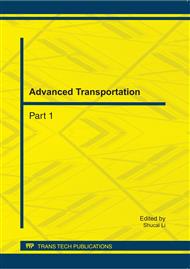p.1158
p.1162
p.1168
p.1176
p.1181
p.1185
p.1189
p.1195
p.1201
The Timing of Urban Rail Transit Construction Based on the Weighted Gray Correlation
Abstract:
In order to clear rail lines of the construction of the timing, the need for each line analysis and evaluation of scientific and rational manner, thus forming a good construction planning program. Analysis of the impact of rail transit construction timing factors, and presented its quantitative methods; further established based on the weighted gray correlation of urban rail transit construction methods and sequence the steps to solve the model. Finally, an example of Xi'an rail transit network in the timing of the construction. The results show that the proposed method using the results of the same order with the actual construction, the method is simple and has good application prospects.
Info:
Periodical:
Pages:
1189-1194
Citation:
Online since:
September 2011
Authors:
Price:
Сopyright:
© 2011 Trans Tech Publications Ltd. All Rights Reserved
Share:
Citation:


